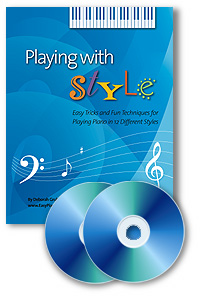PIANO CHORDS
Technique for Practicing Your Chords
You should learn all chords in both hands. In the beginning when you are playing songs, the right hand has the melody and the left hand uses chords. But as you get better and if you want to sing while you play, the right hand needs to get more involved. The right hand would not play the melody in that case. It would play the chords.
Start with the left hand low on the piano. (C below low C is a good starting point). Play the C chord, then play the next C chord with the right hand, one octave apart. Follow this by the left hand, then the right, moving up the piano with the chord one octave up. Keep a nice steady beat. Practicing with a metronome is a great idea. Set it at a slow pace and gradually increase the tempo day by day. Only play as fast as you can play accurately. If you are not getting to the chord in time, go slower.
PLAY SLOWLY TO LEARN QUICKLY.
Let's Turn These Chords Upside Down!
There are essentially three positions that you can play a major or minor chord in. These positions are:
Root Position, First Inversion, and Second Inversion
Root Position - This means that you play the root of the chord (the name of the chord)on the bottom which would be the lowest note. The middle note would follow which is the third, then the fifth on top. For the left hnad, the pinky would play the root, the middle finger plays the third and the thumb plays the fifth. The position would be the same for the right hand except the thumb would play the root, the middle finger plays the third and the pinky plays the fifth.
First Inversion - To play a chord in first inversion, you simply take the root of the chord off the bottom(lowest note) and put in on the top(highest note) of the chord. So the order of the notes in the chord change. For the left hand, the pinky now plays the third, the middle finger plays the fifth and the thumb plays the root. If you are playing a first inversion chord in your right hand, the thumb would play the third (bottom note). The second finger plays the fifth and the pinky plays the root.
Second Inversion - To play a chord in second inversion, this means that the fifth is now the bottom note of the chord, followed by the root in the middle and third on top. So the left hand would play the fifth with the pinky, next the root with the second finger and the third with the thumb. For the right hand, the thumb would play the fifth with the thumb, the root with the third finger and the third of the chord with the pinky finger.
Check out Chords TO GO which will drill you on all of the major, minor, dominant seventh and minor seventh chords while you are driving the car, taking a walk or even watching T.V.
Gets into all inversions and quizes you are parts of chords. Excellent CD for really learning your chords cold!
 $15.99
$15.99
And once you know your chords, the sky is the limit in terms of embellishments and breaking the chords up between the two hands. You are now ready for Playing With Style- Book and 2 CD program. $39.00
 * The three families of chords you absolutely MUST know to play any popular song.
* The three families of chords you absolutely MUST know to play any popular song.
* 5 Things that every musician knows to create great music
* One surefire trick to make all your melodies sound hip and bluesy!
* How to use rolls and arpeggios to fill in the music when the melody stops
* THE BEST WAY to learn your chords without mindless drills. Most piano books and teachers do NOT teach this way
* Easy ways to break up chords so you can play folk songs and children's songs right away
* Learn how to incorporate blues riffs in the right hand and the left hand to add that extra "umph!" to your songs.
Playing With Style
Do you like what you see on this site? Then refer a friend to us. Very easy to do. Just click on this link!
Enjoy this page? Please pay it forward. Here's how...
Would you prefer to share this page with others by linking to it?
- Click on the HTML link code below.
- Copy and paste it, adding a note of your own, into your blog, a Web page, forums, a blog comment,
your Facebook account, or anywhere that someone would find this page valuable.





 $15.99
$15.99 * The three families of chords you absolutely MUST know to play any popular song.
* The three families of chords you absolutely MUST know to play any popular song.
